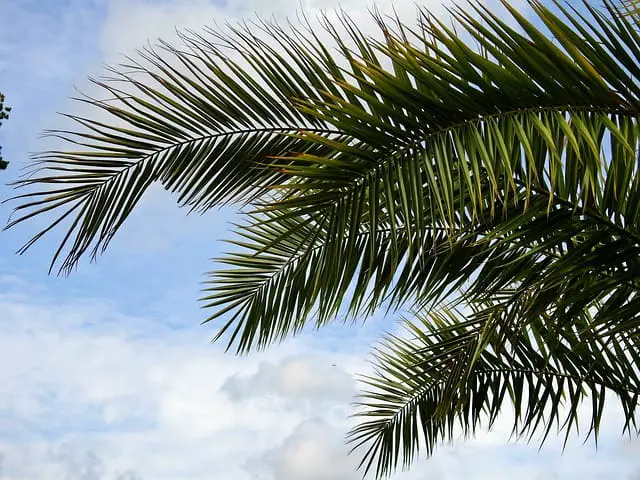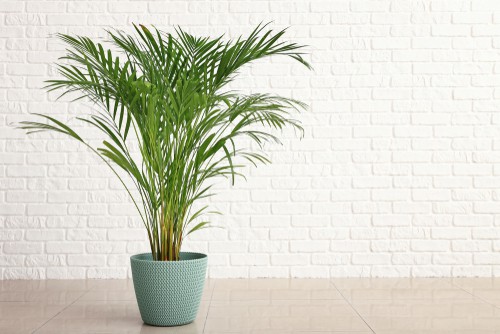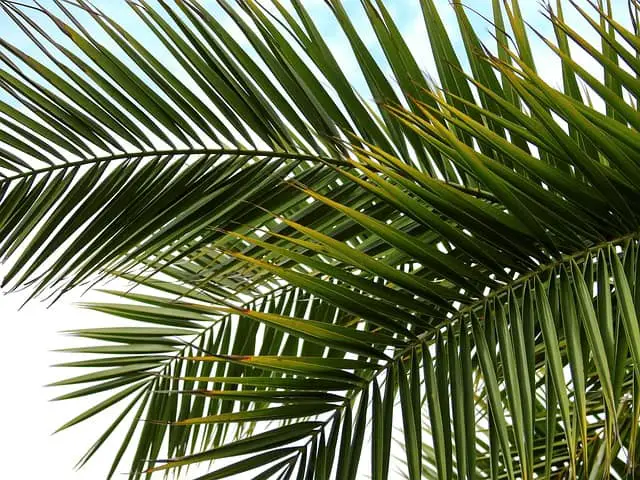Brown spots on palm leaves are a common problem that can be caused by a variety of factors. If left untreated, these spots can spread and eventually kill the entire palm tree. However, with proper identification, it is possible to treat brown spots on palm leaves.
Understanding the causes of brown spots on palm leaves is the first step in treating the problem. Common causes include fungal infections, bacterial infections, nutrient deficiencies, and environmental factors such as overwatering or underwatering.
Identifying the specific cause of the brown spots is essential in determining the appropriate treatment.
Treatment options for brown spots on palm leaves vary depending on the cause of the problem. In some cases, simply adjusting watering and fertilization practices can solve the issue.
In other cases, more aggressive measures such as fungicides or insecticides may be necessary. Preventative measures such as proper pruning and regular inspections can also help prevent brown spots from developing in the first place.
Key Takeaways
- Identifying the cause of brown spots on palm leaves is crucial in determining the appropriate treatment.
- Treatment options for brown spots on palm leaves vary depending on the cause of the problem.
- Preventative measures such as proper pruning and regular inspections can help prevent brown spots from developing.
Also see:
- How to Treat Brown Spots on Orchid Leaves
- How to Treat Brown Spots on Fig Leaves
- How to Treat Brown Spots on Cucumber Leaves
Understanding Brown Spots on Palm Leaves

Brown spots on palm leaves are a common issue for many palm tree owners. These spots can be caused by a variety of factors, including pests, diseases, and environmental stressors. Understanding the cause of the brown spots is crucial for treating the issue effectively.
1. Brown Spots on Palm Leaves – 4 Common Problems
There are several reasons why brown spots might appear on palm leaves. Some common causes include:
- Pests: Pests such as spider mites, mealybugs, and palm aphids can cause brown spots on palm leaves.
- Diseases: Fungal diseases such as leaf spot diseases can cause brown spots on palm leaves.
- Nutritional Deficiencies: A lack of nutrients such as magnesium or manganese can cause brown spots on palm leaves.
- Environmental Stressors: Environmental stressors such as overwatering, underwatering, or exposure to extreme temperatures can cause brown spots on palm leaves.
2. Identifying the Cause of Brown Spots on Palm Leaves
Identifying the cause of brown spots on palm leaves is essential for effective treatment. Here are some steps to follow when trying to identify the cause:
- Inspect the Leaves: Carefully examine the leaves with brown spots. Look for any signs of pests or fungal growth.
- Check the Soil: Check the soil to see if it is too wet or too dry. Soil that is too wet can cause root rot, while soil that is too dry can cause nutrient deficiencies.
- Consider Environmental Factors: Consider any recent changes in the environment, such as extreme temperatures or exposure to direct sunlight.
3. Treating Brown Spots on Palm Leaves
Treatment for brown spots on palm leaves will depend on the cause. Here are some general tips for treating the issue:
- Pests: Use a pesticide specifically designed for the type of pest causing the issue.
- Diseases: Apply a fungicide to the affected leaves.
- Nutritional Deficiencies: Apply a palm-specific fertilizer containing the necessary nutrients.
- Environmental Stressors: Adjust watering and sunlight levels to ensure the palm is not being over or under-exposed.
In conclusion, brown spots on palm leaves can be caused by a variety of factors, including pests, diseases, and environmental stressors. Identifying the cause is crucial for effective treatment. By following the steps outlined above, palm tree owners can effectively treat brown spots and keep their trees healthy and vibrant.
Common Causes of Brown Spots

Brown spots on palm leaves can be caused by a variety of factors, including nutritional deficiencies, pest infestations, fungal and bacterial infections, and environmental factors. In this section, we will explore each of these causes in more detail.
1. Nutritional Deficiencies
Nutritional deficiencies are a common cause of brown spots on palm leaves. When a palm tree lacks essential nutrients such as iron, magnesium, potassium, and manganese, it can result in yellowing of leaves, browning tips, and brown spots.
A nutrient imbalance can also cause stunted growth and poor overall health. To prevent nutritional deficiencies, it is important to fertilize your palm tree regularly and ensure that it is receiving the appropriate nutrients.
2. Pest Infestations
Pests such as spider mites, scale insects, and mealybugs can cause brown spots on palm leaves. These pests feed on the plant’s sap, which can cause discoloration and browning of leaves.
Insect infestations can also weaken the palm tree and make it more susceptible to other diseases. To prevent pest infestations, it is important to regularly inspect your palm tree for signs of pests and take appropriate measures to control them.
3. Fungal and Bacterial Infections
Fungal and bacterial pathogens can also cause brown spots on palm leaves. Common diseases that cause brown spots include Graphiola leaf spot, Fusarium wilt, and Ganoderma butt rot.
These diseases can cause withering and drooping of older fronds, as well as the appearance of orange spots and black spots on the stems and roots. To prevent fungal and bacterial infections, it is important to maintain proper air circulation, avoid overhead irrigation, and use appropriate fungicides and copper-based bactericides.
4. Environmental Factors
Environmental factors such as exposure to direct sunlight, cold weather, drought, and poor drainage can also cause brown spots on palm leaves. Lack of sunlight or too much sunlight can cause discoloration and browning of leaves, while cold weather and drought can cause browning and withering of leaves.
Poor drainage can cause the soil to become waterlogged, which can lead to fungal infections and root rot. To prevent environmental factors from causing brown spots, it is important to provide adequate water and moisture, maintain proper soil pH, and ensure proper drainage.
Identifying the Problem

Brown spots on palm tree leaves can be caused by a variety of factors, including disease, pests, nutrient deficiency, inadequate watering, and exposure to direct sunlight. Identifying the underlying problem is crucial to effectively treating the brown spots and preventing further damage to the palm tree.
One common cause of brown spots on palm leaves is leaf spot diseases, which are caused by fungal or bacterial pathogens. Symptoms of leaf spot diseases include the appearance of small, circular or irregular brown spots on the leaves, which may be surrounded by a yellow halo.
Over time, the spots may grow larger and merge together, causing the leaves to turn brown and fall off. Graphiola leaf spot, caused by the fungus Graphiola phoenicis, is a common leaf spot disease that affects only palms in the Arecaceae family. False smut, caused by another fungus, can also cause brown spots on palm leaves.
Pests such as spider mites, mealybugs, and scale insects can also cause brown spots on palm leaves. These pests feed on the sap of the leaves, causing discoloration and black spots. Sooty mold, a fungal infection that grows on the honeydew excreted by these pests, can also cause brown spots on palm leaves.
Nutrient deficiencies, such as a lack of boron or imbalanced soil pH, can cause yellowing of leaves, stunted growth, and brown spots on palm leaves. Overwatering or poor drainage can lead to root rot, which can cause the leaves to turn brown and wither. Underwatering or drought can also cause brown spots and browning leaves.
Exposure to direct sunlight or too much sunlight can cause brown tips and orange spots on palm leaves. Inadequate watering or low humidity can also cause brown spots on palm leaves, especially in houseplants.
Identifying the specific cause of brown spots on palm leaves is crucial to determining the appropriate treatment. Fungicides, copper-based or otherwise, may be necessary to treat fungal infections.
Pests can be controlled with insecticides or by improving air circulation around the palm tree. Nutrient deficiencies can be corrected with fertilizers or soil amendments. Improving watering practices and providing adequate sunlight and humidity can also help prevent brown spots on palm leaves.
Treatment Options for Brown Spots

Brown spots on palm leaves can be caused by a variety of factors, including nutritional deficiencies, pests, fungi, and environmental stressors. Fortunately, there are several treatment options available to help restore the health and vitality of your palm trees.
1. Nutritional Supplements
One common cause of brown spots on palm leaves is a lack of essential nutrients. To address this issue, consider adding a high-quality fertilizer to the soil around your palm trees. Look for a fertilizer that is specifically formulated for palm trees, as these products typically contain the right balance of nutrients to support healthy growth.
In addition to fertilizer, you may also want to consider adding other nutritional supplements to the soil. For example, magnesium and iron are both important micronutrients that can help prevent brown spots on palm leaves. You can find these supplements at most garden centers or online.
2. Pest Control Methods
Pests such as spider mites, mealybugs, and aphids can also cause brown spots on palm leaves. To control these pests, consider using an insecticide that is safe for use on palm trees. Be sure to follow the instructions carefully and apply the insecticide as directed.
3. Fungal and Bacterial Treatment
Fungal and bacterial infections can also cause brown spots on palm leaves. To treat these issues, look for a fungicide or bactericide that is specifically formulated for palm trees. Be sure to apply the product as directed and monitor your trees closely for any signs of improvement.
4. Environmental Adjustments
Finally, environmental stressors such as improper watering or excessive sunlight can also cause brown spots on palm leaves. To address these issues, consider adjusting your watering schedule or providing shade for your trees. You may also want to have your soil tested to ensure that it has the right balance of nutrients and pH levels.
By taking a proactive approach to treating brown spots on palm leaves, you can help ensure the long-term health and vitality of your palm trees. With the right treatment, your trees can thrive and continue to provide beauty and shade for years to come.
Preventing Brown Spots on Palm Leaves

Preventing brown spots on palm leaves is a crucial part of maintaining healthy and vibrant palm trees. Here are some tips to help prevent brown spots on palm leaves:
1. Proper Care
Palm trees require proper care to stay healthy. Proper care includes regular pruning, fertilizing, and watering. Pruning is essential to remove dead or dying fronds, which can harbor pests and diseases.
Fertilizing helps to provide the necessary nutrients for the palm tree to grow healthy and strong. Watering should be done regularly, but not too frequently, to avoid overwatering, which can lead to root rot.
2. Humidity
Palm trees thrive in humid environments, but too much humidity can lead to the growth of fungal diseases. It is essential to maintain the right level of humidity to avoid brown spots on palm leaves. A humidity level of 50-60% is ideal for most palm trees.
3. Watering
Overwatering or underwatering can lead to brown spots on palm leaves. It is essential to water the palm tree correctly to avoid this problem. The soil should be moist but not waterlogged. To check if the soil is moist, stick your finger into the soil up to the second knuckle. If the soil feels moist, do not water the palm tree.
4. Air Circulation
Proper air circulation is crucial to prevent brown spots on palm leaves. Palms should be spaced apart to allow for adequate air circulation. This helps to reduce humidity and prevent fungal diseases from forming.
5. Prevention
Prevention is the best way to avoid brown spots on palm leaves. Regular inspections of the palm tree can help to identify any problems before they become severe. Removal and destruction of severely infected palm fronds can help minimize disease spread.
By following these tips, homeowners can prevent brown spots on palm leaves and keep their palm trees healthy and vibrant.
Frequently Asked Questions

How can I treat black spots on my palm leaves?
Black spots on palm leaves are usually caused by a fungal infection. To treat this, you can use a fungicide containing copper. Apply the fungicide as a preventative treatment during the spring.
If the palm is used for food purposes, copper fungicides are the only approved fungicides. You should also remove any affected leaves to prevent the spread of the fungus.
What are the best ways to prevent brown spots on indoor palm leaves?
To prevent brown spots on indoor palm leaves, you should make sure that the palm is not overwatered or underwatered. You should also provide adequate humidity and avoid exposing the palm to extreme temperatures.
Regularly inspect the palm for any signs of pests or disease, and promptly treat any issues that arise.
What is the most effective treatment for palm fungus?
The most effective treatment for palm fungus is to use a fungicide containing copper. Apply the fungicide as a preventative treatment during the spring.
If the palm is used for food purposes, copper fungicides are the only approved fungicides. You should also remove any affected leaves to prevent the spread of the fungus.
Why do fan palm leaves turn brown and how can I fix it?
Fan palm leaves can turn brown due to a variety of reasons, including overwatering, underwatering, nutrient deficiencies, and pest infestations. To fix this issue, you should identify the underlying cause and take appropriate action.
This may involve adjusting the watering schedule, providing additional nutrients, or treating any pests that are present.
What are the common causes of yellow and brown palm leaves?
Yellow and brown palm leaves are usually caused by overwatering, underwatering, nutrient deficiencies, or pests.
To prevent this, you should make sure that the palm is not overwatered or underwatered, provide adequate nutrients, and regularly inspect the palm for any signs of pests or disease.
Is it necessary to remove brown leaves from a palm tree and how should I do it?
It is necessary to remove brown leaves from a palm tree to prevent the spread of disease and pests. To remove the leaves, use a sharp, clean pair of pruning shears.
Cut the leaf as close to the trunk as possible without damaging the trunk. Make sure to dispose of the leaves properly to prevent the spread of disease.

Hey, I’m Lisa and I’ve been an avid gardener for over 30 years. I love writing, talking and living in the garden! Feel free to connect with me on my socials below


